Buying Guide for the Best Travel Converter For Ireland
Choosing a travel converter for Ireland is important if you want to safely use your electronic devices while traveling. Ireland uses a different plug type and voltage than many other countries, so a travel converter ensures your devices can be plugged in and operate correctly. The right converter will protect your devices from damage and make your trip much more convenient. To pick the best one, you should understand the key features and how they relate to your needs.Plug Type CompatibilityPlug type compatibility refers to whether the converter fits the wall outlets in Ireland. Ireland uses the Type G plug, which has three rectangular prongs. This is important because if your converter doesn't match the local plug type, you won't be able to use it at all. Some converters come with interchangeable plugs for different countries, while others are specific to one region. If you travel to multiple countries, a universal adapter with multiple plug types is useful. If you only need it for Ireland, a single Type G adapter is sufficient.
Voltage ConversionVoltage conversion is about changing the electrical voltage from the local standard to what your device needs. Ireland uses 230V, which is higher than the 110V used in some countries like the US. This is crucial because plugging a 110V device into a 230V outlet without conversion can damage your device. Some adapters only change the plug shape and do not convert voltage, while converters actually change the voltage. If your device is 'dual voltage' (marked as 110-240V), you only need a plug adapter. If not, you need a voltage converter. Always check your device's label before choosing.
Wattage CapacityWattage capacity tells you how much power the converter can handle at once. This is important because if your device uses more power than the converter can handle, it could overheat or fail. Converters are usually divided into low-wattage (for phones, cameras, and small electronics) and high-wattage (for hair dryers, irons, and other heat-producing devices). Check your device's wattage and make sure the converter can handle at least that much. For most travelers, a low-wattage converter is enough, but if you plan to use high-powered devices, look for a higher capacity.
Number of Outlets and USB PortsThe number of outlets and USB ports determines how many devices you can charge at once. This is important if you have multiple devices like a phone, tablet, and camera. Some converters have just one outlet, while others offer several outlets and USB charging ports. If you travel with several gadgets, choose a converter with multiple ports to avoid waiting for one device to finish charging before plugging in another.
Size and PortabilitySize and portability refer to how easy it is to carry the converter with you. This matters because bulky converters can take up valuable space in your luggage and be inconvenient to use. Converters come in various sizes, from compact single-plug adapters to larger units with multiple outlets. If you want to travel light, look for a compact and lightweight model. If you need to charge many devices at once, you might need a slightly larger one.
Safety FeaturesSafety features include things like surge protection, overheat protection, and fuse systems. These are important because they protect both your devices and you from electrical problems like power surges or overheating. Some converters have built-in safety features, while others do not. If you are using expensive or sensitive electronics, look for a converter with good safety features to give you peace of mind.

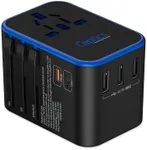
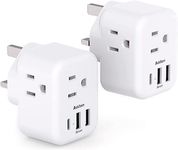

![[1-Pack] UK Ireland Travel Plug Ada](https://images-proxy.bestreviews.guide/fhueV0W1wb3-eccVym-Yb8JX_So=/0x150/https://m.media-amazon.com/images/I/31ZT4uWvPrL._AC_CX679_.jpg)


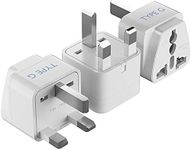
![[1-Pack] UK Travel Plug Adapter, VI](https://images-proxy.bestreviews.guide/WLcMr_Wpk3pRU_YjpUFO215AAxM=/0x150/https://m.media-amazon.com/images/I/411misUiKUL._AC_CX679_.jpg)
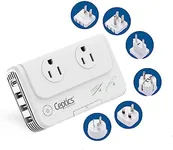

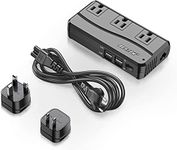

![[2-Pack] Canada to UK Plug Adapter, VINTAR UK Ireland Travel Plug Adapter with 2 USB Ports and 2 American Outlets, 4 in 1 International Power Adaptor for England Singapore Dubai Hongkong (Type G)](https://images-proxy.bestreviews.guide/4bnrnuhVjSYLxLWOgLfMVKjcqsE=/0x150/https://m.media-amazon.com/images/I/41UpA1Hp0oL._AC_CX679_.jpg)





